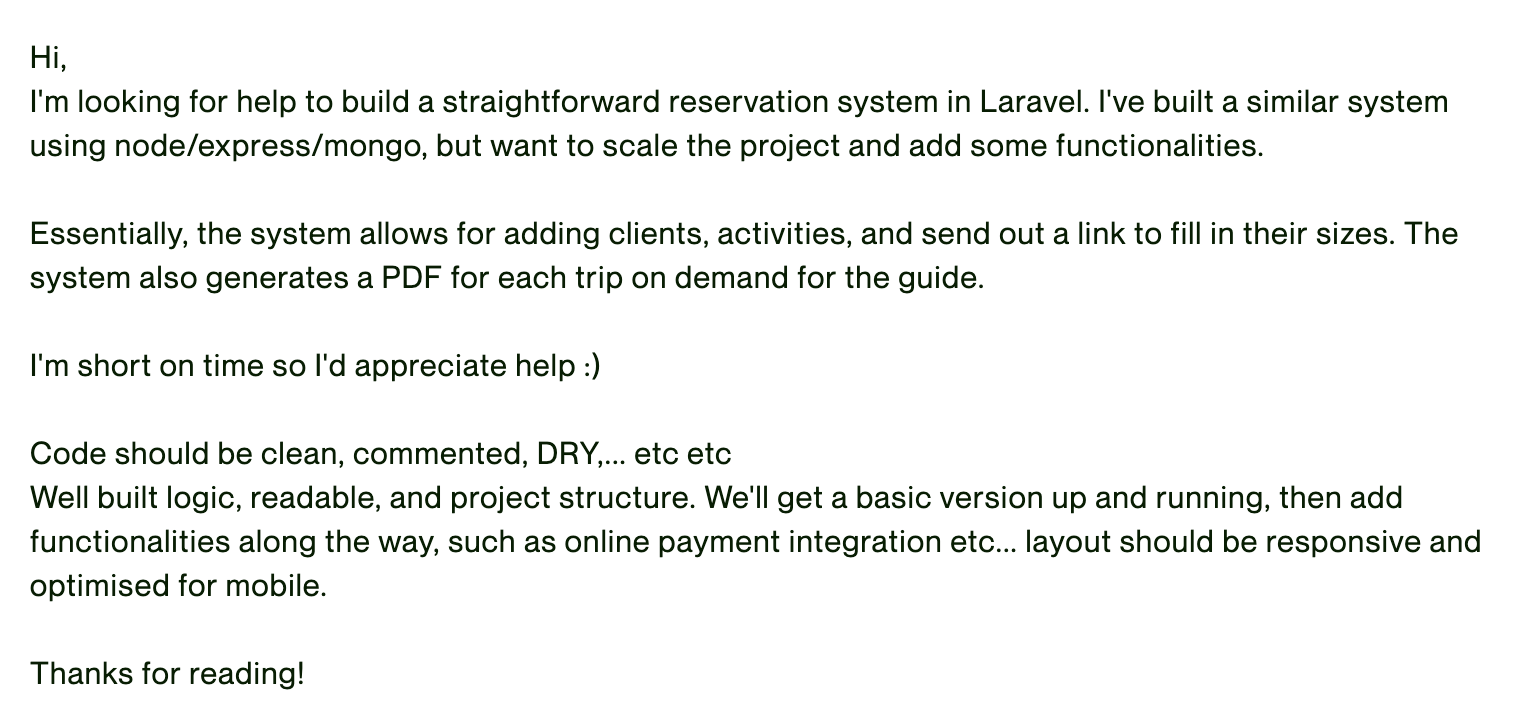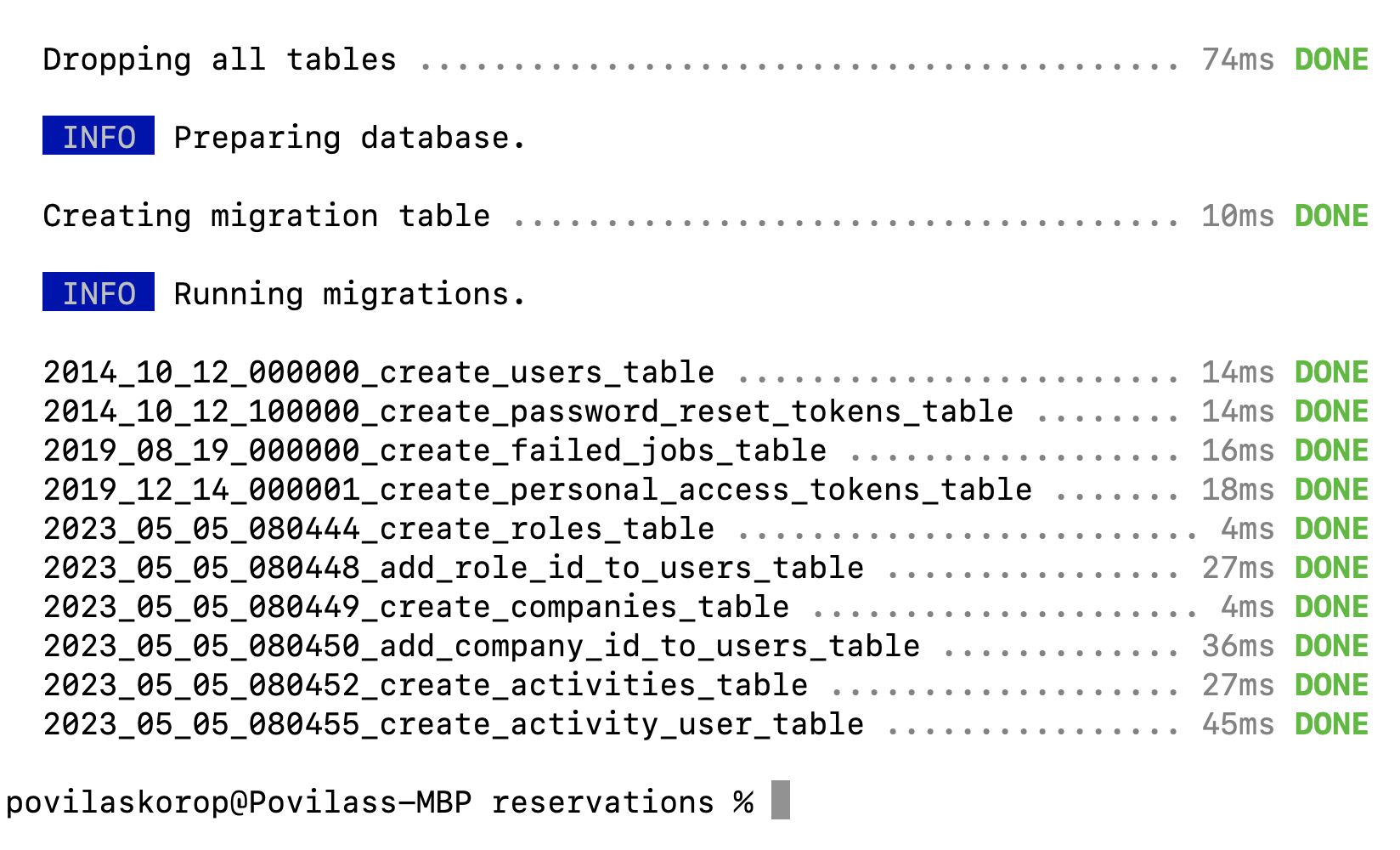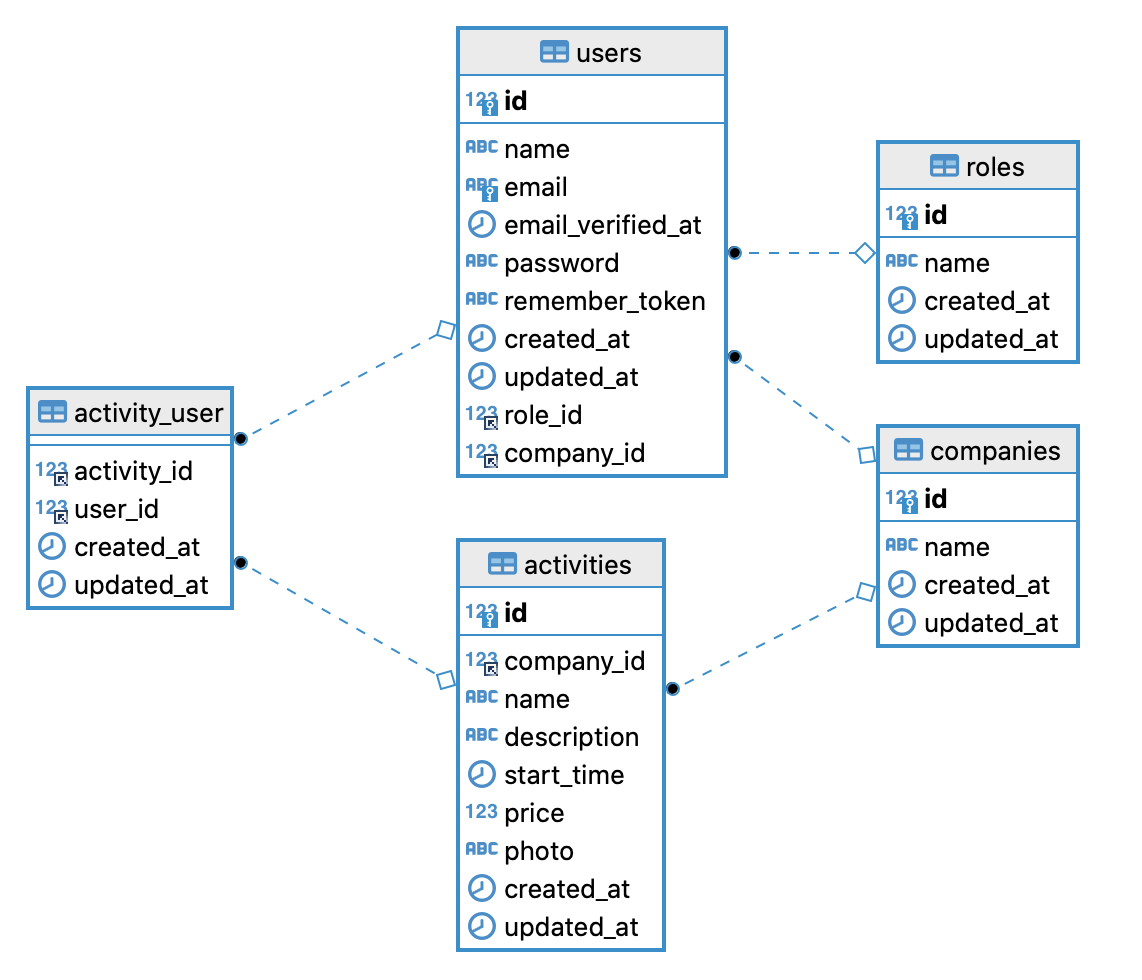Our first goal, before even starting the coding process, is to transform the initial job description from the client into a proper plan of action. There are many ways to do this, and I will explain my own way.
Initial Description from Client
Let's take a look at the initial description of the project, based on a real job from Upwork:

This is how typically clients describe the projects, right? In their own words, briefly, without digging into details. And that's fine, they are not specialists.
So the job of a developer, especially a freelancer, is this:
- Transform it into a real plan of action
- While preparing that plan, gather and ask many questions
- Review/edit that plan after getting the answers
Generally, I see my goal as transforming the description into these three concrete things:
- DB Tables Schema and Models
- List of Features to Build
- Step-by-Step Plan of Actions (a SORTED version of feature list above)
So, let's try to work on exactly that, one by one.
Of course, a lot of things are totally unclear in this simplified job description, and we don't have the contact with the client to ask, so we will assume a lot in the course below.
DB Tables Schema and Models
After re-reading the brief job description, I noted down the list of entities which is just a fancy word meaning the equivalent of Eloquent Models or DB Tables.
Also, I immediately try to envision the fields of the tables, cause that may lead to follow-up questions to the client
-
Roles: just one field
name(I envision roles: "administrator", "company owner", "customer" and "guide") -
Users: typical default Laravel DB table, adding
role_id(we will manage simple permissions in Gates, no DB table needed) -
Companies: just one field
name- for activity organizers -
Activities:
company_id,guide_id,name,description,start_time,price,photo(s) -
Participants: which is actually a pivot table
activity_userwith two foreign keys
And that's it! So it seems that we will have a very small project, but will cover all the Laravel basics to make it very practical and learn a lot.
Remember: at this point, your goal is not to build a perfect DB schema from the beginning, but identify the unclear parts which would lead to the list of questions to the client.
Laravel Project, Migrations, and DB Schema
What I like to do immediately is to visualize the relationships. There are different tools for this, but my personal preference is to spin up a Laravel project, create migrations, run them, and prepare the visual schema from a real database, instead of drawing and entering DB table/column names in some external tool.
So...
laravel new reservationscd reservationsAnd we have a new Laravel project!
Then, these Terminal commands generate models and migrations:
php artisan make:model Role -mphp artisan make:migration add_role_id_to_users_tableRoles Migrations:
public function up(): void{ Schema::create('roles', function (Blueprint $table) { $table->id(); $table->string('name'); $table->timestamps(); });}app/Models/Role.php:
class Role extends Model{ use HasFactory; protected $fillable = ['name'];}Adding Role ID Migration:
Schema::table('users', function (Blueprint $table) { $table->foreignId('role_id')->constrained();});app/Models/User.php:
use Illuminate\Database\Eloquent\Relations\BelongsTo; class User extends Authenticatable{ protected $fillable = [ 'name', 'email', 'password', 'role_id' ]; // ... public function role(): BelongsTo { return $this->belongsTo(Role::class); }}Next, creating companies.
php artisan make:model Company -mphp artisan make:migration add_company_id_to_users_tableCompanies migration:
Schema::create('companies', function (Blueprint $table) { $table->id(); $table->string('name'); $table->timestamps();});app/Models/Company.php:
class Company extends Model{ use HasFactory; protected $fillable = ['name'];}Adding Company ID Migration:
Schema::table('users', function (Blueprint $table) { $table->foreignId('company_id')->nullable()->constrained();});Notice: in this case, a company may be nullable, because only one role will belong to a company.
app/Models/User.php:
use Illuminate\Database\Eloquent\Relations\BelongsTo; class User extends Authenticatable{ protected $fillable = [ 'name', 'email', 'password', 'role_id' 'company_id' ]; // ... public function company(): BelongsTo { return $this->belongsTo(Company::class); }}Finally, the schema for activities.
php artisan make:model Activity -mphp artisan make:migration create_activity_user_tableActivities Migration:
Schema::create('activities', function (Blueprint $table) { $table->id(); $table->foreignId('company_id')->constrained(); $table->foreignId('guide_id')->nullable()->constrained('users'); $table->string('name'); $table->text('description'); $table->dateTime('start_time'); $table->integer('price'); $table->string('photo')->nullable(); $table->timestamps();});Notice: For now, I don't overcomplicate the photo(s) field and plan to save just the filename, but this will actually be one of the questions to the client (we'll get to the questions below). Eventually, we may move to use Spatie Media Library with its own media DB table. The technical solution isn't that important at this stage.
app/Models/Activity.php:
use Illuminate\Database\Eloquent\Relations\BelongsTo;use Illuminate\Database\Eloquent\Relations\BelongsToMany; class Activity extends Model{ use HasFactory; protected $fillable = [ 'company_id', 'guide_id', 'name', 'description', 'start_time', 'price', 'photo' ]; public function company(): BelongsTo { return $this->belongsTo(Company::class); } public function participants() { return $this->belongsToMany(User::class)->withTimestamps(); }}Activity participants migration:
Schema::create('activity_user', function (Blueprint $table) { $table->foreignId('activity_id')->constrained(); $table->foreignId('user_id')->constrained(); $table->timestamps();});Notice 1: I've named the relationship participants() and not just users(), for more clarity.
Notice 2: Pretty sure it will be important to know WHEN someone registered for the activity, so I added withTimestamps() to this pivot table.
And now, we run the migrations on the empty DB table...
php artisan migrate
Now, when we have the DB schema, we can use any external tool to export it as a visual, with relationships. I personally use DBeaver for this, which gives us this result:

Great!
Now, wait, our goal wasn't the DB schema, we planned to create a plan of action and a list of questions for the client?
Feature List
Ok, now as our DB entities are clear(er), we can try to list the features our application will need.
I do that as a "quick braindump", in no particular order, just what comes to mind, for each role:
Admin:
- Manage companies and their users
- View / Manage activities
Company owner:
- Manage guides for their companies
- Manage activities and assign guides
Public:
- View all activities
- Register for the activity
Customer:
- View MY activities
- Cancel my reservations
Guide:
- View activities I'm assigned to
- Export PDF of participants
Looks cool to me. Now, let's try to reorder that list and transform it into a plan of action.
Plan of Actions
This is essentially the same as above, but thinking about implementation.
One of the goals is to build the actual "calendar" of tasks for us and to discover which feature depends on other features to be built earlier.
After some tweaking, I came up with this list, numbered this time:
- DB structure (done)
- Laravel Breeze with CRUD of Companies
- Roles/permissions: Manage companies is only for the admin role (here we'll start writing tests for each feature)
- Admin: managing users of the company (adding multi-tenancy)
- Login with company role: manage guides
- Company role: manage activities and assign guides
- Sending an email to the guide
- Company users can also view/manage activities
- Public homepage with a list of activities
- Registration to the activity as a customer
- Login with customer role: view my activities and cancel them
- Login with guide role: view my activities
- Guide export PDF
This is, of course, a draft that may change a lot, but it's something to start with.
The next step is "thinking exercise": imagine going through those steps in your mind, and your brain should automatically come up with a bunch of questions on how exactly things should work. Note them down.
List of Questions To Ask Client
So if I was a freelancer who saw this job post, I would think about a bunch of things unclear in my head. The best way to "unclear" your mind in such situations is to, well, just ask the client.
In fact, I have won many freelance pitches for projects just by starting with a conversation and questions, instead of just telling "I'm a developer with X years of experience and I can build this project for you".
So, these are just some of the questions I would ask:
- You haven't mentioned anything about visual design: do you have something in mind? Or would you want to pick from these design templates? (attaching a link)
- Would each company have only one user who would manage activities or multiple? (would cost extra)
- What information is needed for the activity: title, description, photos, price? Anything else?
- Can the guide be assigned to only one company or multiple? How do they get invited or register on the system?
- What should the PDF for the guide look like? Do you have any examples?
- Do any emails need to be sent automatically? Reminders for customers/guides?
- Look, I've prepared this DB schema, does it look accurate to you? What fields are missing?
The last one is the most powerful. Yes, the client isn't technical and may not understand DB design. But it does look partly like a human-friendly diagram of objects, so they should be able to get the overall idea and comment on the fields. Also, they would immediately see that you already invested significant time in the project (although in reality, it's 1-hour max) and you are more likely to win this job.
From there, you can start a conversation with the client, discussing that some extra features would take more time (in the client's mind, cost more money), in other places you may "cut corners" to deliver faster, etc.
This course is not about freelancing, but I feel I'm talking about that angle quite a lot here. So I'll get back to the coding part, and if you're interested in freelance pitches in general, check this Youtube playlist or my e-book about freelancing.
Ok, so with this exercise, we have our Plan of Action, which we will follow (or change a bit) in the upcoming lessons. Let's go build the thing!
Povilas, you tagged this course for July 2023. probably a typo?
Hi, oh someone actually found a new course that I haven't tweeted/youtubed about yet, well done!
I planned to release it in July originally, but things changed a bit and yeah, forgot to change the official date in the database. Thanks for noticing!
Question if I am using Uuid in the users table do I need to change the following code to reflect that $table->foreignId('guide_id')->nullable()->constrained('users'); To $table->foreignUuid('guide_id')->nullable()->constrained('users'); ?
Yes, correct, you need to change that. See the end of this lesson
would be good idea to put capacity number of participant on each activity
Good suggestion!
this project remeind me bokun system , Mr Povilas i forgot to say to you after 5 month of your cources i get my first freelance project , THANK YOU .
Great to hear, glad to help!
Another great course! I missed the estimate of time spent on the project. Maybe per action in the list of "Plan of actions". Also something the client would like to know?
That's the part I've intentionally missed because it depends on the skills of developer, and also during the course there were a few "plan corrections". So I intentionally didn't calculate the time.
From the top of my head, I would guess - a week of work or so?
Hi,
Its good course, can you post estimate of time spent on the project ?
Thanks
That's the part I've intentionally missed because it depends on the skills of developer, and also during the course there were a few "plan corrections". So I intentionally didn't calculate the time.
From the top of my head, I would guess - a week of work or so?
Can't we put section of Customers for Company owners so that they get an idea that how many customers have done registrations as well as if any one has cancelled it or not as well as more details they manage in future (like revenues, reporting etc)
Yes, quite a good idea for the future features.
Love the text based course format! So easy to jump in right where you need it.
Why we need to make a table for Role? Why you don't just use that Enum class and replace foreignId with a tinyInteger for role_id?
I mean, considering that you don't have any other column exept 'name' in Role table, just that Enum class couldn't do the job? What is benefits of making a table for it?
Thank you for your greate work here.
Because later if you want to add more roles or rename them, you wouldn't need to ask the developer to do it each time, but someone could do it from adminpanel, without any code deployments.
DBeaver diagram does not correspond to what the actual generated diagram is. For example, the
activitiestable has an FK reference tousersvia columnguide_id.It seems that they first made the MVP and then divided it into lessons/parts. Many lessons show screenshots/examples of code that precede events, so at the point when the example is shown there will actually be an error. For example, in one of the lessons, the test checks for the presence of a thumbnail in the activity, although the thumbnail functionality is added in the next lesson. Or a screenshot of the working page is displayed, although the route to this page is added after several paragraphs, etc. Therefore, when reviewing the course, I often had to be distracted, to understand why something does not work.
Thank you for the feedback, Dmytro.
Yes, that's how we always create the courses: first, create the actual project to have a proof that it all actually works, and only then create the course about it, re-creating the project the second time. I think, that's the correct way, otherwise there would be a lot of unclear things "along the way".
But maybe in this case I've mixed some details, I will re-read the course and see what parts can be improved/fixed. Thanks again.
Thanks for sharing DBeaver https://dbeaver.io/! Pretty nifty!